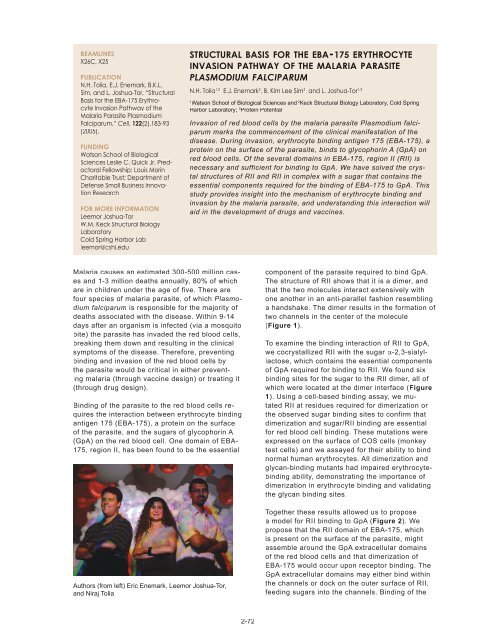NSLS Activity Report 2006 - Brookhaven National Laboratory
NSLS Activity Report 2006 - Brookhaven National Laboratory
NSLS Activity Report 2006 - Brookhaven National Laboratory
Create successful ePaper yourself
Turn your PDF publications into a flip-book with our unique Google optimized e-Paper software.
BEAMLINES<br />
X26C, X25<br />
PUBLICATION<br />
N.H. Tolia, E.J. Enemark, B.K.L.<br />
Sim, and L. Joshua-Tor, “Structural<br />
Basis for the EBA-175 Erythrocyte<br />
Invasion Pathway of the<br />
Malaria Parasite Plasmodium<br />
Falciparum,” Cell, 122(2),183-93<br />
(2005).<br />
FUNDING<br />
Watson School of Biological<br />
Sciences Leslie C. Quick Jr. Predoctoral<br />
Fellowship; Louis Morin<br />
Charitable Trust; Department of<br />
Defense Small Business Innovation<br />
Research<br />
FOR MORE INFORMATION<br />
Leemor Joshua-Tor<br />
W.M. Keck Structural Biology<br />
<strong>Laboratory</strong><br />
Cold Spring Harbor Lab<br />
leemor@cshl.edu<br />
Malaria causes an estimated 300-500 million cases<br />
and 1-3 million deaths annually, 80% of which<br />
are in children under the age of five. There are<br />
four species of malaria parasite, of which Plasmodium<br />
falciparum is responsible for the majority of<br />
deaths associated with the disease. Within 9-14<br />
days after an organism is infected (via a mosquito<br />
bite) the parasite has invaded the red blood cells,<br />
breaking them down and resulting in the clinical<br />
symptoms of the disease. Therefore, preventing<br />
binding and invasion of the red blood cells by<br />
the parasite would be critical in either preventing<br />
malaria (through vaccine design) or treating it<br />
(through drug design).<br />
Binding of the parasite to the red blood cells requires<br />
the interaction between erythrocyte binding<br />
antigen 175 (EBA-175), a protein on the surface<br />
of the parasite, and the sugars of glycophorin A<br />
(GpA) on the red blood cell. One domain of EBA-<br />
175, region II, has been found to be the essential<br />
Authors (from left) Eric Enemark, Leemor Joshua-Tor,<br />
and Niraj Tolia<br />
STRUCTURAL BASIS FOR THE EBA-175 ERYTHROCYTE<br />
INVASION PATHWAY OF THE MALARIA PARASITE<br />
PLASMODIUM FALCIPARUM<br />
N.H. Tolia 1,2 , E.J. Enemark 2 , B. Kim Lee Sim 3 , and L. Joshua-Tor 1,2<br />
1 Watson School of Biological Sciences and 2 Keck Structural Biology <strong>Laboratory</strong>, Cold Spring<br />
Harbor <strong>Laboratory</strong>; 3 Protein Potential<br />
Invasion of red blood cells by the malaria parasite Plasmodium falciparum<br />
marks the commencement of the clinical manifestation of the<br />
disease. During invasion, erythrocyte binding antigen 175 (EBA-175), a<br />
protein on the surface of the parasite, binds to glycophorin A (GpA) on<br />
red blood cells. Of the several domains in EBA-175, region II (RII) is<br />
necessary and sufficient for binding to GpA. We have solved the crystal<br />
structures of RII and RII in complex with a sugar that contains the<br />
essential components required for the binding of EBA-175 to GpA. This<br />
study provides insight into the mechanism of erythrocyte binding and<br />
invasion by the malaria parasite, and understanding this interaction will<br />
aid in the development of drugs and vaccines.<br />
2-72<br />
component of the parasite required to bind GpA.<br />
The structure of RII shows that it is a dimer, and<br />
that the two molecules interact extensively with<br />
one another in an anti-parallel fashion resembling<br />
a handshake. The dimer results in the formation of<br />
two channels in the center of the molecule<br />
(Figure 1).<br />
To examine the binding interaction of RII to GpA,<br />
we cocrystallized RII with the sugar α-2,3-sialyllactose,<br />
which contains the essential components<br />
of GpA required for binding to RII. We found six<br />
binding sites for the sugar to the RII dimer, all of<br />
which were located at the dimer interface (Figure<br />
1). Using a cell-based binding assay, we mutated<br />
RII at residues required for dimerization or<br />
the observed sugar binding sites to confirm that<br />
dimerization and sugar/RII binding are essential<br />
for red blood cell binding. These mutations were<br />
expressed on the surface of COS cells (monkey<br />
test cells) and we assayed for their ability to bind<br />
normal human erythrocytes. All dimerization and<br />
glycan-binding mutants had impaired erythrocytebinding<br />
ability, demonstrating the importance of<br />
dimerization in erythrocyte binding and validating<br />
the glycan binding sites.<br />
Together these results allowed us to propose<br />
a model for RII binding to GpA (Figure 2). We<br />
propose that the RII domain of EBA-175, which<br />
is present on the surface of the parasite, might<br />
assemble around the GpA extracellular domains<br />
of the red blood cells and that dimerization of<br />
EBA-175 would occur upon receptor binding. The<br />
GpA extracellular domains may either bind within<br />
the channels or dock on the outer surface of RII,<br />
feeding sugars into the channels. Binding of the

















